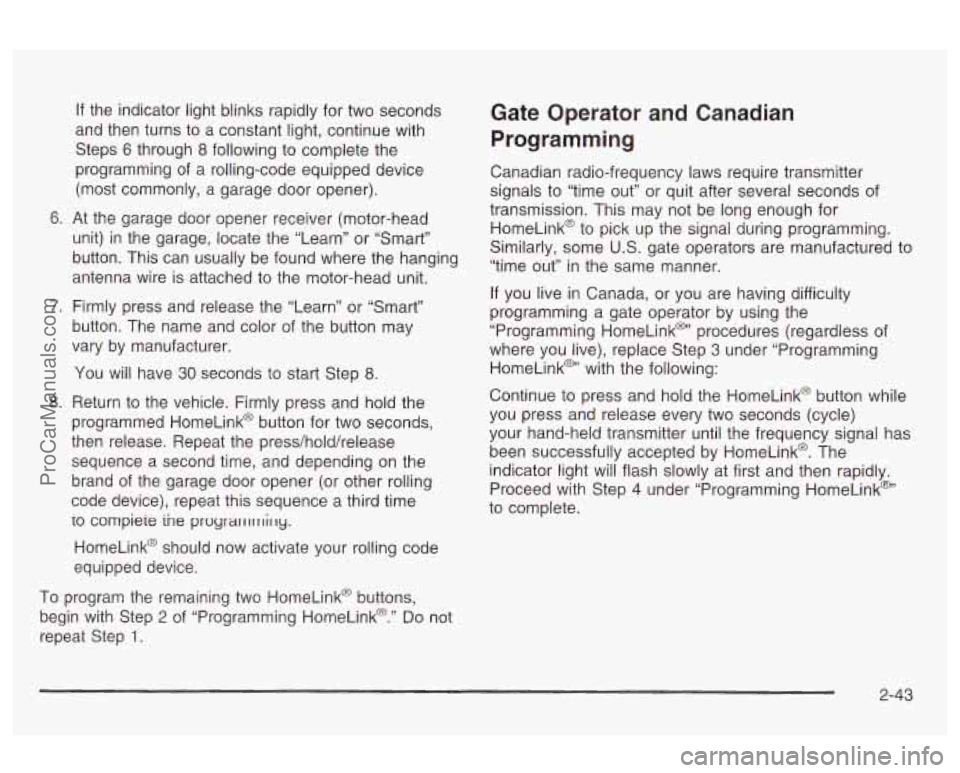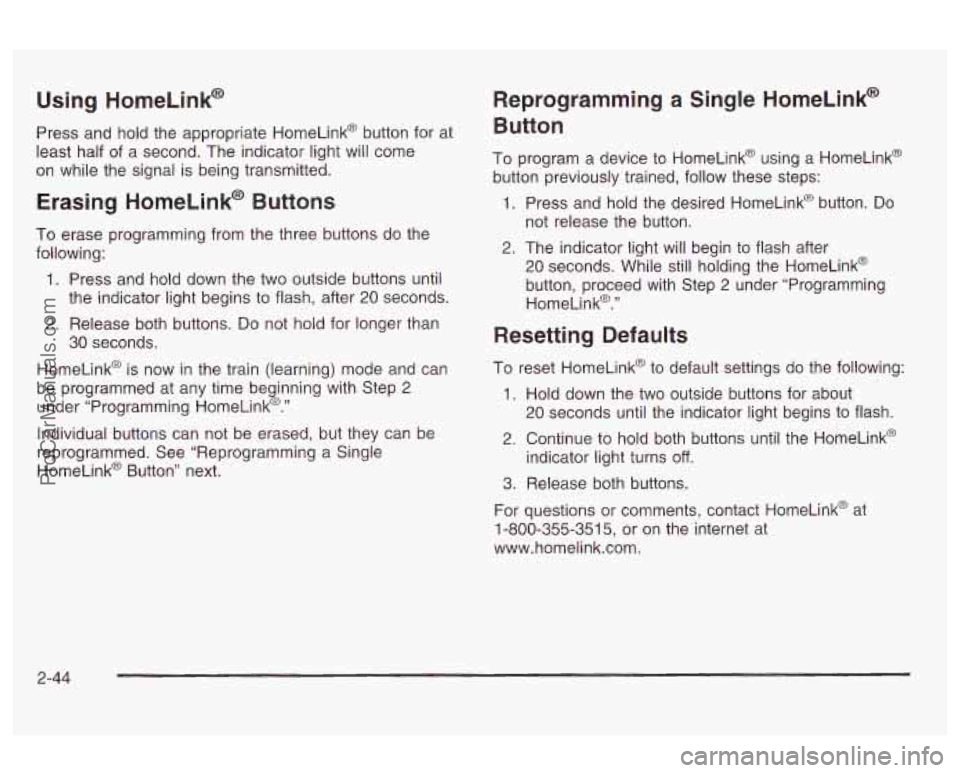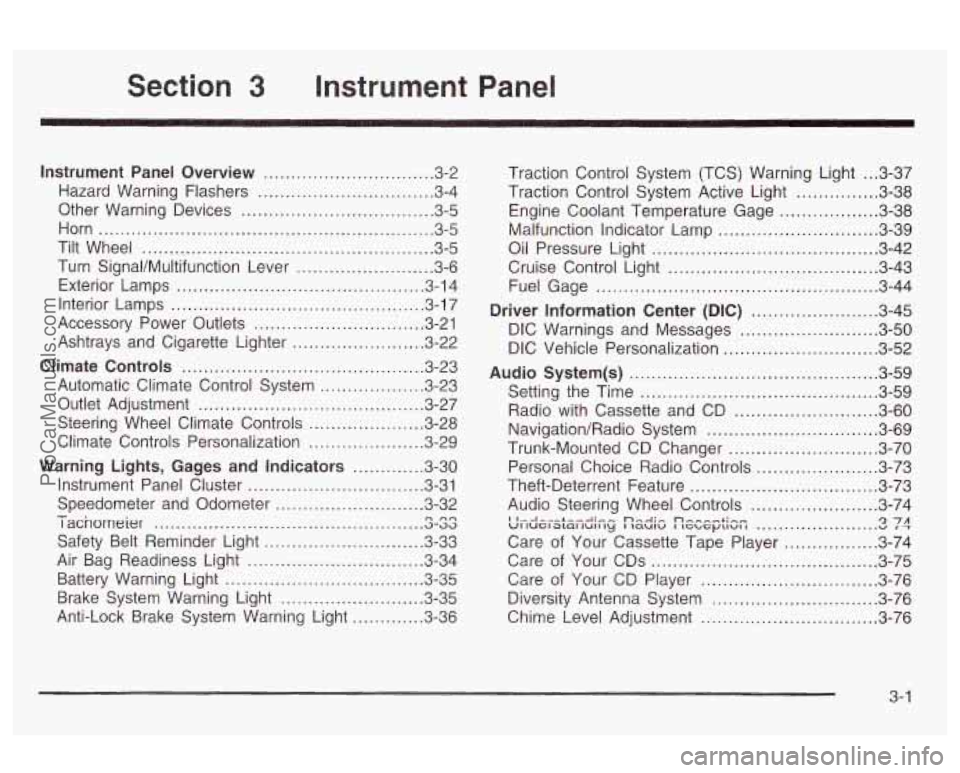light OLDSMOBILE AURORA 2003 Owner's Manual
[x] Cancel search | Manufacturer: OLDSMOBILE, Model Year: 2003, Model line: AURORA, Model: OLDSMOBILE AURORA 2003Pages: 387, PDF Size: 18.05 MB
Page 106 of 387

If the indicator light blinks rapidly for two seconds
and then turns to a constant light, continue with
Steps
6 through 8 following to complete the
programming of a rolling-code equipped device
(most commonly, a garage door opener).
6. At the garage door opener receiver (motor-head
unit) in the garage, locate the “Learn” or “Smart”
button. This can usually be found where the hanging
antenna wire is attached to the motor-head unit.
7. Firmly press and release the “Learn” or “Smart”
button. The name and color of the button may
vary by manufacturer.
You will have
30 seconds to start Step 8.
8. Return to the vehicle. Firmly press and hold the
programmed HomeLink@ button for two seconds,
then release. Repeat the press/hold/release
sequence a second time, and depending on the
brand of the garage door opener (or other rolling
code device), repeat this sequence a third time
io compieie ine proyrarrllllirly.
HomeLink@ should now activate your rolling code
equipped device.
To program the remaining two HomeLink@ buttons,
begin with Step
2 of “Programming HomeLink@.” Do not
repeat Step
1.
Gate Operator and Canadian
Programming
Canadian radio-frequency laws require transmitter
signals to “time out” or quit after several seconds of
transmission. This may not be long enough for
HomeLinkO to pick up the signal during programming.
Similarly, some
U.S. gate operators are manufactured to
“time out” in the same manner.
If you live in Canada, or you are having difficulty
programming a gate operator by using the
“Programming HomeLink@’ procedures (regardless of
where you live), replace Step
3 under “Programming
HomeLinkm’ with the following:
Continue to press and hold the HomeLink@ button while
you press and release every two seconds (cycle)
your hand-held transmitter until the frequency signal has
been successfully accepted by HomeLink@. The
indicator light will flash slowly at first and then rapidly.
Proceed with Step
4 under “Programming HomeLink@”
to complete.
2-43
ProCarManuals.com
Page 107 of 387

Using HorneLink@
Press and hold the appropriate HomeLink@ button for at
least half
of a second. The indicator light will come
on while the signal is being transmitted.
Erasing HorneLink@ Buttons
To erase programming from the three buttons do the
following:
1. Press and hold down the two outside buttons until
the indicator light begins to flash, after 20 seconds.
2. Release both buttons. Do not hold for longer than
HomeLink@ is now in the train (learning) mode and can
be programmed at any time beginning with Step
2
under “Programming HomeLink@.”
Individual buttons can not be erased, but they can be
reprogrammed. See “Reprogramming a Single
HomeLink@ Button” next.
30
seconds.
Reprogramming a Single HomeLink@
Button
To program a device to HomeLink@ using a HomeLink@
button previously trained, follow these steps:
1. Press and hold the desired HomeLink@ button.
Do
not release the button.
2. The indicator light will begin to flash after
20 seconds. While still holding the HomeLink@
button, proceed with Step
2 under “Programming
HomeLink@.”
Resetting Defaults
To reset HomeLink@ to default settings do the following:
1. Hold down the two outside buttons for about
20 seconds until the indicator light begins to flash.
2. Continue to hold both buttons until the HomeLink@
indicator light turns
off.
3. Release both buttons.
For questions or comments, contact HomeLink@ at
1-800-355-351
5, or on the internet at
www.homelink.com.
2-44
ProCarManuals.com
Page 110 of 387

Sunroof
If your vehicle has this
option, the switches are
located on the headliner
between the sun visors.
There are two switches that operate the sunroof. The
switches will only work when the ignition is on or when
RAP is active. See “Retained Accessory Power
(RAP)” under
lgnition Positions on page 2-23.
The OPENKLOSE switch has positions for open or
close and express open. The TILTKLOSE switch has
pnsitinns fnr tilt or close.
Comfort Stop: Press and release the OPEN/CLOSE
switch rearward to the second position to express open
the glass panel to the comfort stop position. The
comfort stop position
is designed to help reduce noise
and make the passengers more comfortable.
Express Open: The glass panel may be fully opened
by pressing the OPEN/CLOSE switch rearward
again. When the glass panel is express opening,
pressing either switch in any direction will stop it.
If you
press and hold the OPENKLOSE switch in the
express open position for more than one and a half
seconds, the express open operation will be overridden
and the sunroof will operate manually.
Tilt: To tilt open the glass panel, press and hold the
TILTKLOSE switch. The sunshade must be opened
by hand.
Close: To close the glass panel, press and hold the
OPENKLOSE or TILTKLOSE switch in the close
position.
As the glass panel reaches the closed position,
it will open slightly towards the tilt position and then
drup ciowr I iu ii le puSiiiui-1 pro~ibe z b&i~; SZS!.
Open: Press and hold the OPEN/CLOSE switch to the
first position to open the glass panel and sunshade.
The sunshade can also be opened by hand.
2-47
ProCarManuals.com
Page 114 of 387

3 Instrument Panel
Instrument Panel Overview .............................. -3-2
Hazard Warning Flashers
................................ 3-4
Other Warning Devices
................................... 3-5
Horn
............................................................. 3-5
Tilt Wheel
..................................................... 3-5
Turn SignaVMultifunction Lever
......................... 3-6
Exterior Lamps
............................................. 3-14
Interior Lamps
.............................................. 3-17
Accessory Power Outlets
............................... 3-21
Ashtrays and Cigarette Lighter
........................ 3-22
Climate Controls
............................................ 3.23
Automatic Climate Control System
.................. 3-23
Outlet Adjustment
......................................... 3-27
Steering Wheel Climate Controls
..................... 3-28
Climate Controls Personalization
..................... 3.29
Warning Lights, Gages and Indicators
............. 3-30
Instrument Panel Cluster
............................... -3-31
Speedometer and Odometer
........................... 3-32
I acnorneier .-..
Safety Belt Reminder Light ............................. 3-33
Air Bag Readiness Light
................................ 3-34
Battery Warning Light
.................................... 3.35
Brake System Warning Light
.......................... 3.35
Anti-Lock Brake System Warning Light
............. 3-36
- n no .................................................
Traction Control System (TCS) Warning Light ... 3.37
Traction Control System Active Light
............... 3.38
Engine Coolant Temperature Gage
.................. 3.38
Oil Pressure Light
......................................... 3.42
Cruise Control Light
...................................... 3.43
Fuel Gage
................................................... 3.44
Driver Information Center
(DIC) ....................... 3.45
DIC Warnings and Messages
......................... 3.50
DIC Vehicle Personalization
............................ 3.52
Audio System(s)
............................................. 3.59
Setting the Time
........................................... 3.59
Radio with Cassette and CD
.......................... 3.60
Navigation/Radio System
............................... 3.69
Trunk-Mounted CD Changer
........................... 3-70
Personal Choice Radio Controls
...................... 3.73
Theft-Deterrent Feature
.................................. 3.73
Audio Steering Wheel Controls
....................... 3.74
Care of Your Cassette Tape Player
................. 3-74
Care of Your CDs
......................................... 3-75
Care
of Your CD Player ................................ 3-76
Malfunction Indicator
Lamp
............................. 3.39
I I...I-.-L--A.- ... n,.-J:, n-, --+in- VI luel awl lull ty I laulu I IGL, G~LIUI I u 1 T '2 7A ......................
Diversity Antenna System .............................. 3.76
Chime Level Adjustment
............................... -3-76
3-
1
ProCarManuals.com
Page 120 of 387

As you signal a turn or a lane change, if the arrows
flash very fast, a bulb may be burned out and
other drivers won’t see your turn signal.
If a bulb is burned out, replace
it to help avoid an
accident.
If the arrows don’t go on at all when you signal a turn,
check the fuse (see
Fuses and Circuit Breakers on
page
5-92 ) and check for burned-out bulbs.
Turn Signal On Chime
If your turn signal is left on for more than 0.8 miles
(1.3 km), a chime will sound at each flash of the turn
signal and the DIC will display the TURN SIGNAL
ON?
reminder message. To turn off the chime and
message, move the turn signal lever to the
off position.
To turn off the DIC message while the turn signal is
still active, press any button on the DIC. See
Driver
information Center (DE) on page 3-45 for more
information.
Headlamp High/Low-Beam Changer
To change the headlamps from low beam to high, push
the lever away from you until you hear a click. Then
release it.
When the high beams are
on, this light on the
instrument panel cluster
will also be on.
If the fog lamps are on when you turn on the high-beam
headlamps, the fog lamps will turn
off. The fog lamps
will turn back on when you turn
off the high-beam
headlamps.
3-7
ProCarManuals.com
Page 121 of 387

Flash-to-Pass
This feature lets you use your high-beam headlamps to
signal a driver in front
of you that you want to pass.
It works even
if your headlamps are off.
To use it, pull the turn signal lever toward you.
Your high-beam headlamps will turn on. They’ll stay on
as long as you hold the lever there. Release the
lever
to turn them off.
If your headlamps are on, and on high beam, your
headlamps will switch to low beam when the lever is
released.
To get back to high beam, push the lever away
from you.
Windshield Wipers
The lever on the right side of your steering column
operates your windshield wipers.
If your windshield wipers are on for more than
six
seconds while you are driving, the low-beam headlamps,
instrument panel cluster backlighting and the taillamps
will turn on. For more information see “Wiper-Activated
Headlamps” under
Exterior Lamps on page 3-14.
3-8
ProCarManuals.com
Page 122 of 387

For a single wiping cycle, move the lever down to MIST.
Hold it there until the wipers start, then release it. The
wipers will stop after one cycle.
If you want more cycles,
hold the lever on MIST longer.
For steady wiping at low speed, move the lever up to
the
LO position. For high-speed wiping, move the lever
up further, to HI.
To stop the wipers, move the lever
to OFF.
You can set the wiper speed for a long or short delay
between wiper cycles. Move the lever up to the first
detent, INT (Intermittent). Turn the band labeled
INT ADJ (Intermittent Adjustment) down toward the
shorter lines for fewer wiper passes per minute. As you
turn the band toward the longer lines, the wiper
cycles per minute will increase.
Remember that damaged wiper blades may prevent you
from seeing well enough to drive safely. To avoid
damage, be sure to clear ice and snow from the wiper
blades before using them. If they’re frozen to the
do become damaged, get new blades or blade inserts.
See
Windshield Wiper Blade Replacement on
page
5-59.
Heavy snow or ice can overload your wipers. A circuit
snow or ice to prevent an overload.
\yindrihield, ~~r~f~!Il;/ lcgspn 9~ thl~~! them. !f \/nllr hl=dnc J --’
breaker wi!! stop them unti! the mntnr con!s. C!ear away
RainsenseTM II Wipers
The moisture sensor is mounted on the interior side of
the windshield below the rearview mirror and is used
to automatically operate the windshield wipers.
This system operates by monitoring the amount of
moisture build-up on the windshield. Wipes occur as
needed to clear the windshield depending on the driving
conditions and sensitivity setting. In light rain or snow,
fewer wipes will occur. In heavy rain or snow, wipes will
occur more frequently. The system will operate in the
delay, low speed and high speed modes. If the system is
left on for long periods of time, occasional wipes may
occur without any moisture
on the windshield. This
is normal and indicates that the RainsenseTM system is
activated.
3-9
ProCarManuals.com
Page 125 of 387

Resuming a Set Speed
Setting the cruise control at a desired speed and then
applying the brake will end the cruise control function.
Once you’re going about
25 mph (40 km/h) or more, you
can briefly push the cruise control lever up to RES-ACC
(Resume-Accelerate) to reset. This returns you to
the desired preset speed.
Remember,
if you hold the lever up at RES-ACC, the
vehicle will accelerate until you release the lever
or apply the brake.
So unless you want to go faster,
don’t hold the lever at RES-ACC.
Increasing Speed While Using Cruise
Control
1.
2.
3.
4.
Push the cruise control switch, located on the right
side of the steering column at the end of the lever,
in to
ON.
Get up to the speed you want.
Push the lever down to SET-CST (Coast) and
release it. The CRUISE light on the instrument
panel cluster will come on.
Take your foot
off the accelerator pedal. There are
three ways to go to a higher speed:
Use the accelerator pedal to go to a higher speed.
Push the lever down, then release the lever and
the accelerator pedal. You’ll now cruise at the higher
speed.
Move the cruise lever up to RES-ACC. Hold it there
until you reach a desired speed and then release
the lever.
3-1 2
ProCarManuals.com
Page 126 of 387

To increase your speed in very small amounts,
move the lever up to RES-ACC briefly and then
release it. Each time you do this, your vehicle will go
about
1 mph (1 -6 km/h) faster.
The accelerate feature will only work after you have set
the cruise control speed by pushing the lever down
to SET-CST.
Reducing Speed While Using Cruise
Control
There are two ways to reduce your speed while using
cruise control:
@ Push the lever down until you reach a desired lower
speed then release it.
To slow down in very small amounts, push the lever
down briefly. Each time you do this, you’ll go about
1 mph (1.6 km/h) slower.
Passing Another Vehicle While Using
Cruise Control
Use the accelerator pedal to increase your speed.
When you take your foot
off the pedal, your vehicle will
slow down to the cruise control speed you set earlier.
Using Cruise Control on Hills
How well your cruise control will work on hills depends
upon your speed, load, and the steepness of the
hills. When going up steep hills, you may have to step
on the accelerator pedal to maintain your speed.
When going downhill, you may have to brake or shift to
a lower gear to keep your speed down. Of course,
applying the brake takes you out of cruise control. Many
drivers find this to be too much trouble and don’t use
cruise control on steep hills.
Ending Cruise Control Without Erasing the
Set Speed
There are two ways to turn off the cruise control:
* Step lightly on the brake pedal, or
@ pull the cruise lever towards you to cancel cruise.
To resume the set speed see “Resuming a Set Speed”
earlier in this section.
Erasing Speed Memory
When you turn off the cruise control or the ignition, your
cruise control set speed memory is erased.
3-1 3
ProCarManuals.com
Page 127 of 387

Exterior Lamps
The lever on the left side
of the steering column
operates the exterior
lamps.
{OO: (Parking Lamps): Turning the switch to this
position turns on the parking lamps, together with the
following:
Sidemarker Lamps
Taillamps
-:g- : Turn the outside part of the lever with this symbol
on
it, to operate the lamps. The exterior lamp switch
has three positions.
OFF: Turning the switch to this position turns off all
lamps and lights, except the Daytime Running
Lamps
(DRL).
License Plate Lamps
Instrument Panel Lights
- - zo (Headlamps): Turning the switch to this position
turns on the headlamps, together with the previously
listed lamps and lights.
AUTO (Automatic Headlamps): Turning the exterior
lamps control to AUTO will turn the headlamps, taillamps
and parking lamps on and
off, while the ignition is on,
by sensing how dark it is outside. See “Automatic
Headlamp System” later in this section for more
information.
3-1 4
ProCarManuals.com